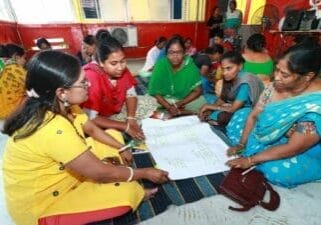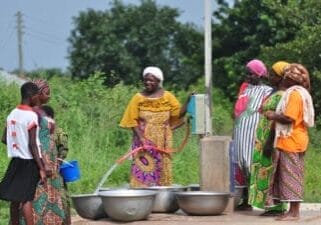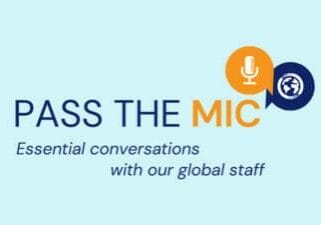News > Blog
More Than Something to Drink: Water & Long Lasting Development
Published 03/22/2017 by Global Communities
More Than Something to Drink: Water & Long Lasting Development
By Franky Li, WASH Technical Advisor for Global Communities | This article originally appeared on Medium.
Women in Ghana are often forced to walk long distances to bring back water for their families.
Water is a basic necessity for life. World Water Day is today, highlighting this fact, as well as the over 600 million people who don’t have access to safe water. But on this year’s World Water Day, I want to move beyond the important stories about those forced to trek many miles to transport clean water to their homes. Increasingly, access to water is not viewed as a separate concern from other development issues, but rather as a vital component of a multi-sectoral approach. My organization, Global Communities, currently works in water, sanitation, and hygiene (WASH) in 12 countries, working on everything from infrastructure to behavior change. In all of these countries, I’ve seen how important water can be for transforming individuals, families, and even whole communities.
One of the most important issues that access to water can help address is malnutrition. Water and food are the two most basic human needs, but the relationship between the two is more complex than most might realize. Untreated water containing diarrhea causing pathogens is a leading cause of malnutrition in children under the age of five. These illnesses disrupt the absorption of key nutrients in the body, and when coupled with more mundane symptoms like loss of appetite, lead to malnutrition as severe as that caused by a lack of food.
In addition, children who already suffer from malnutrition are at a greater risk of suffering from diarrhea, creating the potential for a vicious cycle in which the child’s diarrhea becomes chronic and malnutrition only becomes worse. In short, it simply doesn’t matter how many nutrient rich foods we can get a family to grow and eat if it isn’t being absorbed by their bodies. Clean drinking water is one of the most important tools in fighting these diseases. But preventing the spread of pathogens requires more than a new well, it requires proper sanitation and hygiene practices. The integrated nature of these issues leads to their collective grouping as WASH. Programming that focuses on all of these interdependent aspects can help ensure that access to clean drinking water and ultimately help address a key component in improving nutrition.
We often divide improving water and sanitation from more traditional forms of economic development like jobs training or microfinance. However, water can help provide more than improved health, it can help stimulate the economy in a community. Water infrastructure, from wells to drainage ditches, have to be built, providing construction jobs. Furthermore, once built, any infrastructure is going to have to be maintained, creating a demand for skilled labor that can be filled by members of the community. But even this example is too narrow. In many communities, water vendors and transporters play a vital role in providing safe drinking water for their communities. For people like Joseph Apam Tetteh in Ghana, water vending transformed his life. Born with a disability that left him unemployed, he received support as part of the WASH-Up program, which aims to improve access to water in underserved communities. With this support, he was able to open his water vending business, and is now independent and no longer reliant on family members, while also increasing access to water in his neighborhood. For people like Joseph, investments in water infrastructure can mean more than clean water.
Finally, water can play a critical role as part of larger efforts to strengthen communities and create long-lasting, sustainable change. In the wake of Haiti’s devastating earthquake, Global Communities has worked to rehabilitate and strengthen communities across the country. In all of these programs, an effort was made to include important issues about water access were addressed, from the construction and repair of irrigation and drainage systems to including provisions for latrines and water access when repairing damaged homes. But these efforts often move beyond simply addressing water issues in the process of construction. It is often the case that local governments lack the resources to adequately maintain water infrastructure, and as a result it falls on the community to learn to maintain and repair the equipment needed to ensure a safe water supply. This is facilitated by a participatory and inclusive methodology in which the community has a say in the work being done from its conception, through its execution, and well after completion. Water infrastructure therefore becomes a key, tangible item that the community can take ownership of and manage well into the future. This community buy-in not only helps ensure that people are invested in the maintenance of the water infrastructure, it helps build community bonds and confidence. With their capacity to implement changes improved, they can tackle other issues that the community might face, be it housing, education, or other infrastructure. We have even seen cases where some unintended consequences have resulted from these community-led programs; in the case of Liberia saving countless lives during the Ebola outbreak.
This World Water Day, we must remember the countless people across the globe without access to clean water, and the importance of working to help address this vital issue. But we also must keep in mind that water can mean more than just something to drink or wash with; it can be a vital component for entrepreneurship, or a springboard to community-led developments that can have a lasting impact on countless lives.





